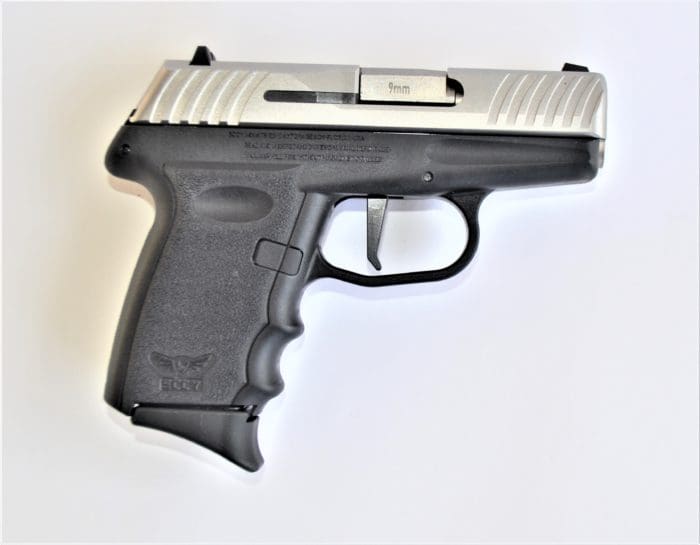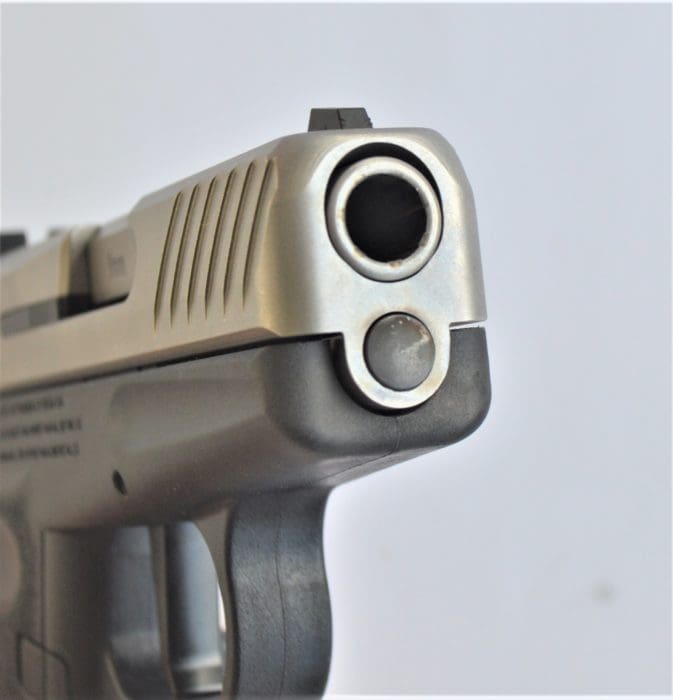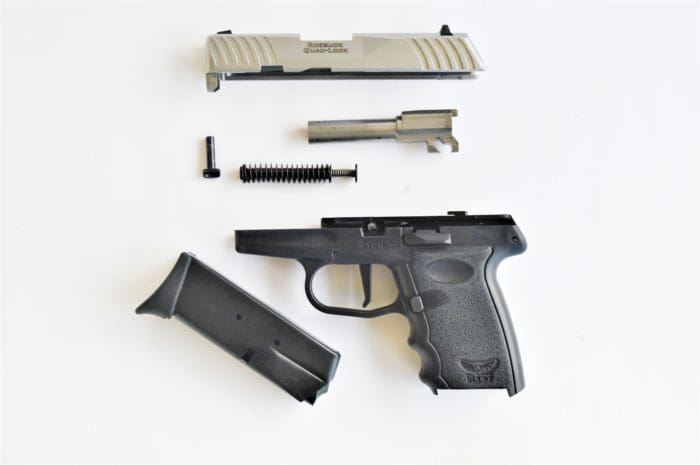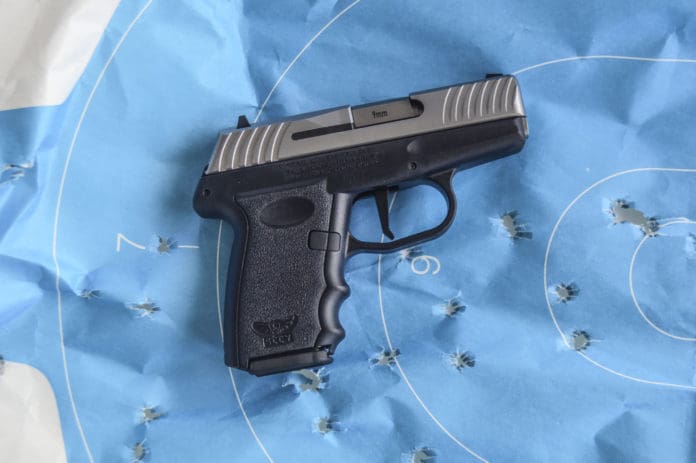By Virgil Caldwell
There is some precedent in re-designing a double action first shot pistol to a striker fired design. SIG morphed the P250 to the P320 and HK created the VP9 in a similar fashion. SCCY has taken their affordably-priced 9mm design, a double-action-only hammer-fired pistol, and made it into a striker fired handgun.
The result is the DVG-1, a pistol with impressive handling and firing characteristics for the price. I have tried quite a few of the SCCY pistols over the years and have seen them in classes I’ve taught. They’re known for being feed- and function-reliable. Some of the early models with a manual safety had a habit of moving to the safe position during a firing string, but that problem has long since been resolved.
The SCCY 9mm pistol originally retailed for a very affordable two hundred dollars or so. The price has crept up some over the years, like everything else, but in the DVG-1, SCCY is still able to offer a very reasonably priced EDC option.
The pistol is intended for easy carry, simple operation, and close range personal defense. You probably won’t be using a DVG-1 for bowling pin matches, but it works perfectly well in its intended use, as a self-defense carry or home defense gun. It is what it is and arming good folks on a budget with a reliable pistol is a praiseworthy thing to do.
In addition to the standard model reviewed here, there’s an optics-ready version (the DVG-1RD) as well that ships with a pre-installed Crimson Trace red dot sight. That model’s priced $100 more than the standard DVG-1.

Unlike SCCY’s earlier hammer-fired pistols, the DVG-1 is striker-fired. The pistol is billed as a sub-compact and size-wise, it’s pretty much in Smith & Wesson Shield Plus range. It isn’t a pocket pistol, save for winter carry in an outside coat pocket. However, a Galco Stow-N-Go IWB holster easily accomodates this handgun for comfortable concealed carry.
Another feature that makes the DVG-1 different from SCCY’s earlier pistols are the forward slide serrations. Otherwise the pistol is dimensionally and aesthetically virtually the same as earlier SCCY pistols.
The barrel is 3.1 inches long and the pistol is 6 inches from end to end. The slide at its widest point is 1.1 inches wide. The slide release adds a piddling amount of width. The pistol comes with the usual gun lock, a manual, and two 10-round magazines.

The height of the pistol varies slightly. Both mags ship with extended baseplates for four-finger operation. SCCY also includes two flush-fit plates should you want the smallest possible package for carry. I don’t think the slightly higher baseplate makes much practical difference carrying the pistol IWB behind the hip under a light T shirt, but your mileage may vary.

The pistol weighs 15.5 ounces unloaded, about the same as an aluminum frame .38 Special snub nose revolver. It isn’t the smallest 9mm pistol you can buy, but it’s probably the smallest and lightest 9mm the occasional shooter will handle well. The DVG-1 is easier to rack than some 9mm striker fired guns, even though it incorporates a dual recoil spring into the design.

You’ll notice SCCY’s prominent Roebuck Quad Lock inscription on the slide. That’s a description of the locking design that SCCY says improves accuracy and reduces wear.

It’s named for SCCY’s founder Joe Roebuck and the design locks the barrel at four areas. Locking it in four places ensures that the barrel returns to the same location every time the pistol cycles and returns to battery. The idea is to eliminate any play or movement in the system.

Takedown is simple enough. Bump out the takedown pin with a screwdriver. This releases the slide to run forward and the rest comes apart easy as pie.
The grip frame is comfortable with adequate stippling to give the shooter a good balance of adhesion and abrasion when gripping the pistol.
Another notable feature of the DVG-1 is a flat trigger shoe. Takeup is long, but isn’t particularly tight…you meet a wall, and the trigger breaks at pretty consistent 6.1 pounds compression on the Lyman digital scale. This is an improvement over the DAO SCCY triggers.
I used a variety of ammunition during testing. I have learned during the last almost two years of scarce ammunition that ‘cheap’ brands tend to go bang and are reliable, too. They’re fine for practice and drills. I used Red Army and Armscor FMJ loads primarily during the test.
Where you don’t want to cut corners, however, is in your personal defense ammunition choice. Many makers with names I have never heard of before claim velocities that are two hundred fps or more less than actually chronographed results. Some of the JHP loads will not expand unless they hit a brick wall. If you’re asked to pay more than the price of Hornady Critical Defense 9mm, be certain of what you’re getting.
I loaded both magazines and began shooting at targets at 5 and 7 yards. Results were good. Some polymer frame pistols are slide heavy. The DVG-1 is remarkably well balanced. Control isn’t difficult. Fire, allow the trigger to reset during recoil, and fire again when the sights are lined up again.
Rounds stayed in the X ring at 7 yards…for the most part. Moving to 10 yards I fired a 10-shot group as quickly as I could regain the sights. All ten shots were within six inches of each other. The DVG-1 is controllable for its weight class and I never found it uncomfortable to fire, whatever load I used.
As for absolute accuracy in firing from a solid bench rest, I fired three five-shot groups at 15 yards. Here are the results . . .

I also fired a single 25-yard group with the Armscor ammo. Seven inches was the grouping size. That’s a long distance with a sub-compact personal defense pistol, but the good news is, you wouldn’t be helpless at that range if you know how to shoot.
Specifications: SCCY DVG-1
Caliber: 9mm
Type: striker-fired semi-auto
Capacity: 10+1
Barrel: 3.1 inches stainless
Overall length: 6.0 inches
Height: 4.5 inches
Weight: 15.5 oz.
Slide: stainless steel
Frame: polymer
Sights: Fixed, sight notch is GLOCK 43 compatible
MSRP: $299 (about $260 retail)
Ratings (out of five stars):
Ergonomics * * * * ½
While there are no replaceable panels for the grip, the DVG-1 is sized right to accommodate most hand sizes. That results in easy concealment and comfortable shooting.
Accuracy * * *
This is a 7 yard gun. It isn’t as accurate as the Taurus GRX, as an example, or many other guns that cost more. But the affordable DVG-1 is more than accurate enough for its intended use as a personal defense gun.
Reliability * * * * *
No failures to feed, chamber, fire or eject. At all. I would rely on it for everyday carry.
Value * * * *
An inexpensive — some would say downright cheap — handgun that works and performs well.
Concealed Carry * * * * *
Only the smallest 9mm slim line guns are smaller and even then, not by much. The DVG-1 is an excellent, easy-to-carry 9mm pistol.
Overall * * * * ½
There’s a lot to be said for turning out reliable, reasonably-priced guns that people who can’t or don’t want to spend a lot of money can afford. SCCY’s been doing that since its inception. SCCY’s striker-fired DVG-1 continues that legacy of selling reliable carry guns at a very affordable price.





Nice writeup. It sounds like good value for the money
I think it is a good value for around $200-220.
For $260, I’d far prefer the superior Taurus G3C (though the G3C is slightly bigger).
This SCCY will work for pocket carry if you use the flush fit baseplate without the pinky extension. I have pocket carried a KelTec P11 before (and the SCCY is an upgraded/improved copy of the P11).
It is nice to see a positive review of a humble pistol like this.
Started out looking for a G3C but have not seen one in stores around here yet. SCCY and sig 365 are about all that makes the stores lately in this size category so at least there are options for an area where gunbroker is a tad bit more complicated. Also happy to see SCCY get an objective review they are quite good for the price.
No, but thanks anyway.
This along with Diamondbacks are currently(not counting ” ring of fire” lorcinlike cobras or JA )some of the worst reviewed handguns ever.
Where would you place SCCY in relation to KelTec or Hi-Point? I’d place SCCY between them. I’d take a KelTec over a SCCY pistol, but I’d take a SCCY pistol over a Hi-Point pistol (but II’d also take a HiPoint carbine over a SCCY pistol).
Taurus G3C, S&W SD9, or Ruger Security Nine, would be light years ahead of any of those.
Pretty much my assessment exactly and would add all pistols mentioned by Art I would say meet minimum acceptable function/safety for actual use and would suggest them if one’s budget was too stressed to save up and needed something asap.
Hopefully these are built a little better than the CPX series. My CPX-2 has been sent back three times in the last 4 years for:
1) Broken firing pin.
2) Broken hammer. [It sheared off where the rollpin attaches the hammer spring to the hammer.]
3) Broken firing pin (again) and broken ejector. [Gun still ejects cases even with the ejector gone. They fly straight up and have a tendency to land on one’s arms or head.]
That said, SCCY did fix the issues quite quickly and had the gun back to me within 2 weeks.
It’s damn near 2022. Who buys a semi auto that has to have a tool to take it down?
Even my half-century old 1911 Llama Extra is toolless takedown. The barrel bushing is rotating lug, not threaded.
The Walther PK380.
One can use the rim of a case or just one’s fingernail to remove the SCCY’s takedown pin. It’s not difficult nor requires any effort.
Ruger’s LC9s / EC9s / MAX-9 series of guns…good luck trying to expediently disassemble them without something like a bent paper clip.
I just bought a Ruger Max 9, and it has a similar takedown. My Ruger Security Nine, Ruger LCP, and old KelTec P11, all take down that way. It works, but Ruger really should use something better.
Even my dirt cheap KelTec P17 .22lr takes down like a Glock.
@Virgil Caldwell
This Old Guy is a bit confused…
“Many makers with names I have never heard of before claim velocities that are two hundred fps or more less than actually chronographed results.”
Didn’t you really mean claimed velocities two hundred feet more than actually chrono’d not less which is how it reads to me?
It is a decent write-up on an economical choice for a self-defense firearm.
No sir.
There are some bad offenders claiming as one example 1280 fps for ammunition that actually clocks as little as 999 fps. The Big Three, Black Hills and Hornady are usually close on factory specs. Clocked Norma .380 ACP claimed 1285, actually did 1000 fps. Sierra 124 grain JHP does 999 fps. Most foreign 9mm FMJ is slow. Only so much can be done with powder capacity. I think Fort Scott is another that never meets specs. Chronographs are cheaper than ever and an interested shooter should have one. Clock your favorite .22 load and keep the records for reference. Another, Double Tap never makes claimed velocity, very low. Buffalo Bore on the other hand is often a bit better than factory claims.
You are right Old Guy in Montanna, it is a confusing sentence.
I am having a hard time breaking it down myself
So does this new version have a DOA striker or is it “semi cocked” or is it fully cocked when a round is in the chamber? I am an old fashioned kind of guy who prefers a safety and if they omitted this in the new model, I would appreciate an added layer of safety when I carry something IWB. I just wish that this review weren’t so parsimonious when it came to descriptions of the product.
5 star HK iike reliabilty in a $200 pistol? Amazing stuff.
I got my wife one of their CPX-2 optic installed pistols because it was such a bargain and didn’t expect much; however, we have had it 2 years now and during that time it has not had hany issues as far as the gun is concerned. The point of problems for many people are the magazines which are cheaply stamped metal and frequently have messed up feed lips from the factory… I was aware of this before I got the pistol so I tuned all the magazines before we went shooting to make sure they would feed correctly. So, imo pistol is GTG for self-defense, but magazines not so much.
Some years ago I bought an SCCY CPX. It was almost impossible for my senior hands to rack the slide. I sold the gun without firing it and bought a Taurus G2 in .40. Easier to rack. I wonder if this would be easier than the CPX.
Two things.
1. It’s always annoyed me about the Sccy pistols that they do not hold 12 rounds. I owned both the cpx2 and the Taurus g2c and both mags were the same dimensions, but Sccy held two fewer rounds. Thumbs down for that.
2. I’ve been seeing DVG1 ads forever, are they actually in stores?
roebuck.
is that a real pistol or is that a sears pistol?
“‘scuse me while i kiss this sccy.” -unlikely utterance by the inevitable successful dgu operator.
Hmmmm…No foolin.
No 1913 rail. SCCY hasn’t molded a rail in any of their pistols. Why not.
Do I see a need for the niche? Sure.
I’ve known several people who bought the CPX as their first gun. Every one, now owns something else. That says volumes to me.
One thing the SCCY’ s have going for them, is they’re not a goofy looking as those Diamondback guns. Those look like my 6 year old Grandson drew their blueprints.
Bottom line- if you can afford better then you should buy a better not.
If you cannot this is an option.
Introducing the new challenger for sub-compact from the king of concealed carry. The DVG-1 pistol series is a striker fired, 9mm sub-compact available with …check here
This is outstanding, but before you proceed to placing an order at jack in the box restaurant, make sure you know jack in the breakfast hours or lunch
For those asking “if someone has my apple id can they see my texts? I want you all to know that’ the answer is yes. But read ….apple id
Inspired from the tv series Yellowstone, this Kelly Reilly Blue Coat is poncho-style outerwear. Kelly Reilly portrayed the role of Beth Dutton, daughter of John Dutton in the series.
If you love to wear action movies and games outfits so must check the top 5 superb Cosplay Jackets which gives you a killer and stunning look on this cosplay festival.
With no doubt, every cash app user should know the important of cash app referral code. Hence, we have shared helpful information on how to share the code and earn free money on cash app
i so much love the model. it is very comfortable and durable to use
Have you been craving for a breakfast meal at Arby’s restaurant? Yes, the first step to take is finding outArby’s breakfast hours. This is very necessary, to avoid driving-in when they have stopped serving breakfast
What’s with all the advertising spam in comments?? Moderator? Anyone? Bueller?
Comments are closed.